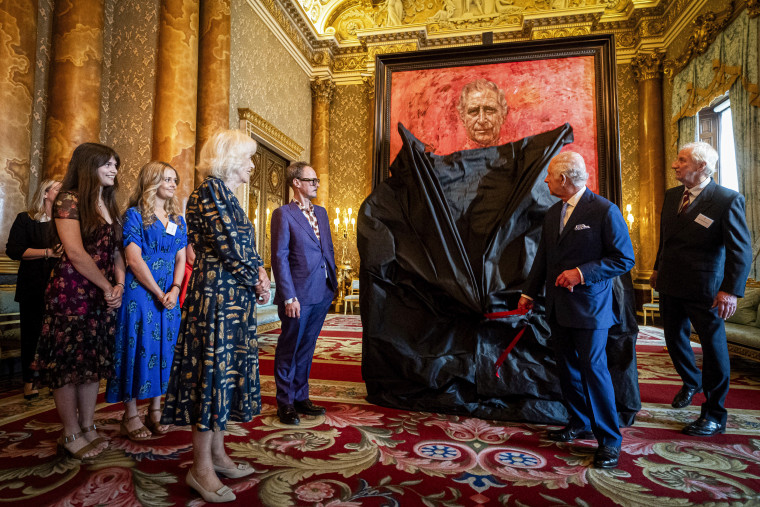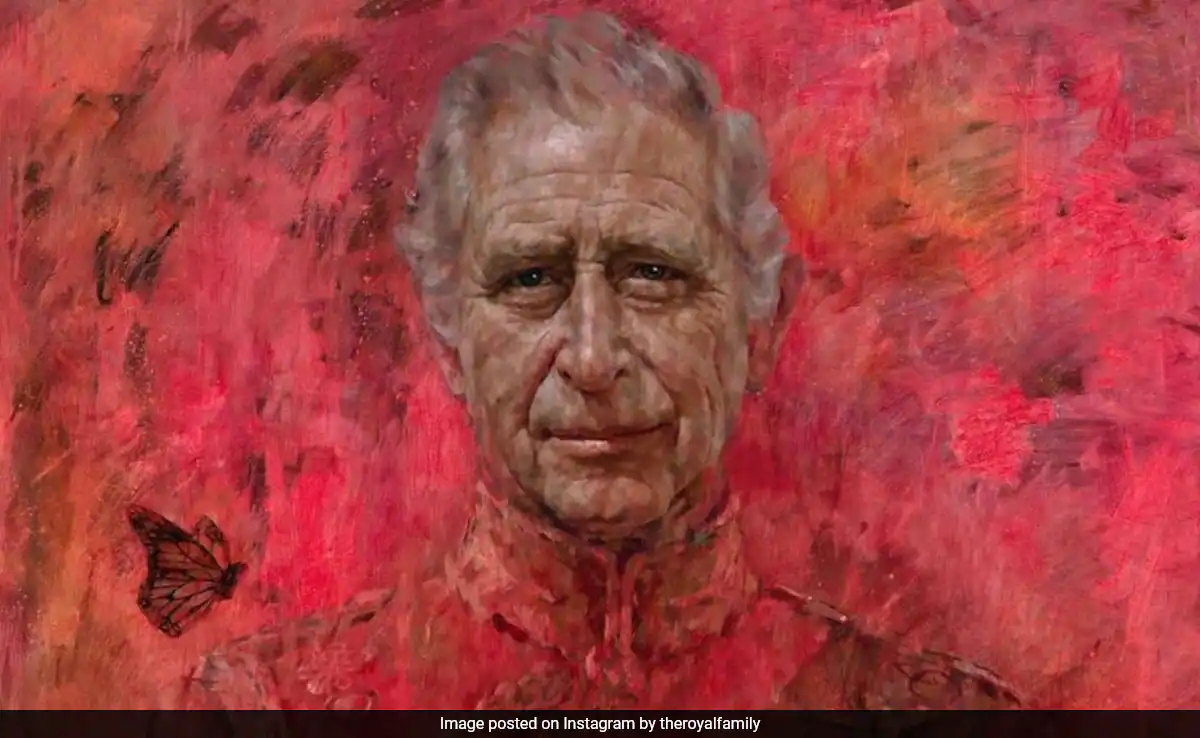Table of Contents
Unveiling the New Portrait: A Historic Addition
We are excited to share a remarkable new painting that joins a long line of royal portraits. For many years, official artworks created by talented painters during their lifetimes have been a tradition in Britain. These special portraits do more than just show what the kings and queens looked like; they also give us a glimpse into their personalities and memorable moments from their time as rulers. Today, King Charles revealed his new official portrait since becoming the monarch, adding it to this impressive collection.

This new portrait is an important historical record that will be treasured for generations to come. Official royal portraits allow artists to capture the essence and spirit of the monarch they are painting. In King Charles’s new portrait, we can see he maintains a dignified yet approachable presence befitting his new role. The portrait gives us a window into how the King carries himself during this significant period in the nation’s history.
The Talented Artist and the Royal Commission
The newly unveiled portrait of King Charles III, created by the renowned artist Jonathan Yeo, was presented at the grand Buckingham Palace. This impressive artwork was commissioned in 2020 with the specific purpose of commemorating the King’s 50 years of dedicated membership in the prestigious and philanthropic organization known as the Draper’s Company. This milestone anniversary was celebrated in 2022. The portrait depicts the monarch adorned in the striking red tunic of the Welsh Guards, a prestigious regiment of which he was appointed Regimental Colonel way back in 1975. The portrait’s unveiling was a significant event, marking not only the King’s long standing association with the Draper’s Company but also his enduring connection with the military.
An explanation on Jonathan Yeo’s website says that in the King’s portrait, his military uniform fades into the background. This painting style focuses on capturing the King’s character and personality more than just his looks. Yeo’s artistic approach lets viewers connect with the deeper parts of the King’s true self. The military outfit blends into the background to highlight the King’s essence beyond his physical appearance. Yeo uses subtle techniques to portray his subjects’ inner qualities and personalities. Instead of only depicting outer looks, his paintings reveal the subjects’ deeper traits and characters. By fading the military regalia into the backdrop, Yeo draws attention to the King’s persona beyond his physical dress and decorations. This signature style prioritizes conveying the subject’s inherent nature and spirit over merely representing external appearances.
Evolution of the Portrait
When artist Jonathan Yeo embarked on this artistic endeavor, King Charles III was still His Royal Highness The Prince of Wales. The portrait underwent a remarkable transformation, mirroring the subject’s evolving role in public life. Yeo eloquently expressed, “Much like the butterfly I’ve painted hovering over his shoulder, this portrait has evolved as the subject’s role in our public life has transformed.” This artistic journey reflects King Charles’s transition from heir to monarch, highlighting the dynamic nature of both the artwork and the man himself, adapting to the shifts in his public responsibilities. As the portrait took shape, it captured not only the physical likeness but also the changing circumstances surrounding the subject. Just as a caterpillar emerges as a butterfly, this artistic creation evolved alongside King Charles’s ascension to the throne.
Capturing the Essence of King Charles
The artist wanted to create a portrait that showed the true character of King Charles. He worked hard to show the life experiences that shaped the King’s face. His goal was to make a modern royal portrait that followed traditions but also showed the human side of the King. Yeo explained that he aimed to capture the King’s life story in his face. He wanted the portrait to feel like a royal painting from long ago but with a modern twist.
The artist hoped to show King Charles as a real person with feelings and experiences, not just a powerful monarch. He tried to blend the classic royal art style with an updated, relatable approach for today’s viewers. Yeo believed it was important to honor historic royal portrait traditions while also connecting with modern audiences. In the end, his main purpose was to reveal the King’s humanity and depth through the artwork.
King Charles’s formal portrait by artist Jonathan Yeo is a landmark event in royal art history. The painting honors King Charles’s achievements and personal growth over the years. It also shows how portraits of today’s kings and queens can be made. By capturing King Charles’s true character and human side, Yeo’s work adds a deep and meaningful masterpiece to Britain’s collection of royal portraits Throughout history, portraits of kings and queens have been important. They let people see and understand what the rulers look like, and they also show the monarch’s power, wealth, and status. Yeo’s portrait of King Charles goes beyond just looks, it gives viewers a sense of who King Charles really is as a person. The artist used his skills to portray the king’s inner qualities like wisdom, kindness, and strength of character.
Public Reaction to the Portrait

The unveiling of the official portrait sparked a wave of diverse reactions across the online community. As the majestic image graced the royal family’s Instagram page, a deluge of comments poured in, reflecting the contrasting perspectives of the public. A chorus of voices resonated through the digital realm, some echoing profound admiration for the artistic masterpiece, while others expressed reservations or critiques.
The portrait is unlike any other royal portrait before it, with a unique and modern style that has really captured people’s attention; King Charles recently sat for a striking new portrait by the talented artist Jonathan Yeo. Many have taken to social media to express their admiration for this special piece of art. One impressed viewer commented “I think this is beautiful and such a break from the traditional portraits” – they clearly appreciated the fresh and innovative approach Yeo took, stepping away from more conventional royal portraits of the past. Another fan gushed “A lovely portrait of King Charles! I love the way the muted background draws attention to his face!” highlighting how the subtle, understated background really allows the viewer’s focus to be drawn to King Charles’s face as the central point of attraction.
Strong Reactions
The stunning painting sparked a variety of strong reactions, Some viewers found the vivid red hues unsettling. One observer noted, “The face is amazing, but the rest looks like a bloody mess.” A critic commented, “I’m sorry, but the portrait makes it seem like he’s trapped in hellfire.” These responses highlighted how the bold color choices divided opinions. Other viewers contemplated deeper meanings behind the artwork’s striking visuals. Someone questioned, “Does the red perhaps symbolize the violence and bloodshed caused by British colonialism?” Another individual initially mistook the piece for satirical commentary, remarking, “I was entirely convinced this was meant as a satirical work at first.”
The range of reactions demonstrated the powerful impact of the painting’s unconventional color palette. While some were captivated by the artist’s technical skill in rendering the subject’s face, others found the pervasive redness jarring or thought provoking. The vibrant hues elicited strong emotions, sparking discussions about the potential symbolic significance behind the bold aesthetic choices.
The Artistic Process
The renowned British artist Jonathan Yeo embarked on a remarkable artistic endeavor, capturing the essence of King Charles III through a series of four dedicated sittings. This monumental oil on canvas painting, measuring an impressive 230 cm by 165 cm, bears witness to a pivotal moment in Britain’s history; the transition of Charles from his role as the Prince of Wales to his ascension as the reigning monarch.
The painting of King Charles III will be displayed at the Philip Mould Gallery in London where people can visit and look at the artwork from May 16th to June 14th. This exhibition gives art lovers and regular folks a chance to see the portrait up close. They can decide for themselves what they think about this important royal painting.
The reveal of King Charles’s official portrait picture has made people feel many different ways. Some people like it and think it is good. Other people do not like it and think it is bad. The variety of thoughts shows how powerful new art can be. This painting challenges the normal way of doing things. It also gets people talking about meaningful topics.
For one whole month, they can study every brushstroke and decide if the artwork is magnificent or lacking. Some may find the painting breathtaking – a brilliant capture of the monarch’s noble spirit. Others might feel it falls short, an uninspired and lackluster rendering. No matter their stance, viewers will surely depart with a renewed appreciation for how art can stir both admiration and controversy within the human soul.



